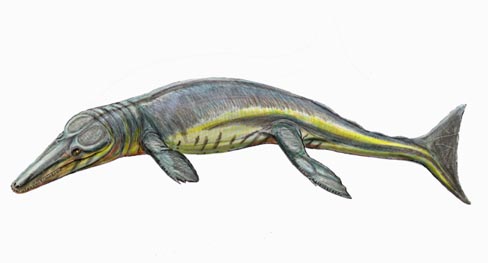Marine Crocodile Super Predator From Leeds that Resided in Peterborough
Oldest Known Metriorhynchid Super Predator from the Middle Jurassic
Some fragmentary bones, including jaw material and teeth unearthed when a Peterborough clay pit (Peterborough in Cambridgeshire, England) was explored by the famous amateur palaeontologist Alfred Leeds, have been identified as a new genus of marine crocodile super predator. The fossils which include isolated teeth, elements of the mandible and some post cranial material, first excavated by Leeds as he examined Oxford Clay strata exposed at the Fletton clay brick pits close to Peterborough have been assigned to the species Tyrannoneustes lythrodectikos representing the oldest, large metriorhynchid crocodilian known to date.
Tyrannoneustes lythrodectikos
Although the actual size of this prehistoric, marine predator is hard to calculate accurately, studies of the teeth and estimates of the gape of the mouth indicate that this reptile was probably an apex predator and the fossil material helps palaeontologists to better understand the evolutionary path taken by marine crocodiles as they competed with other types of marine reptiles in the warm, tropical seas that covered much of England during the Jurassic geological period.
The fossils were discovered around the turn of the 20th century, they were first formally listed in 1919 forming part of the vertebrate fossil collection at the Hunterian Museum at the University of Glasgow. The material remained relatively undisturbed until a team of palaeontologists led by researchers from the Department of Geosciences at the University of Edinburgh had the opportunity to examine the fossil specimens in detail. The team concluded that the fossils represented a new species of giant, marine crocodile that swam in the Middle Jurassic seas around 165 – 163 million years ago.
An Artist’s Impression of the New Genus of Marine Crocodile
Picture credit: Press Association/University of Edinburgh
Middle Jurassic Marine Crocodile
The newly assigned species, helps scientists to piece together a picture of the marine ecosystem during the Middle Jurassic, a time when ichthyosaurs and plesiosaurs shared this environment with the crocodilians.
The Metriorhynchidae are a large family of marine crocodiles that seem to have had their hey day in the Late Jurassic. Fossils of these predatory reptiles have been found in Switzerland, France, England, Germany and also in South America. These animals ranged in size from around two metres in length to apex predators that may have reached lengths in excess of seven metres or more. Dr Mark Young of the School of Geosciences at the University of Edinburgh has studied a number of apex Metriorhynchidae crocodilians, monsters like Dakosaurus and the much larger Plesiosuchus for example. However, such large members of the Metriorhynchidae are associated with more recent Upper Jurassic strata whereas, the fossils ascribed to Tyrannoneustes date from earlier Middle Jurassic deposits.
To view replicas and models of Jurassic prehistoric animals: PNSO Age of Dinosaurs Figures.
This new research, which has just been published in the academic publication “The Journal of Systematic Palaeontology” allows scientists to partially fill a gap in the evolution and radiation of the Metriorhynchidae as these creatures evolved into top predators from smaller genera that specialised in catching fish and cephalopods.
A Formidable Hunter
The wide gape of the mouth and the teeth capable of shearing flesh and bone would have made this marine crocodile a formidable hunter, the fearsome nature of this beast is reflected in the scientific name Tyrannoneustes lythrodectikos, which means “blood-biting tyrant swimmer”.
Dr Mark Young, one of the authors of this study commented that:
“It was satisfying to be able to classify a specimen that has been unexamined for more than one hundred years, and doubly so to find that this discovery improves our understanding of the evolution of marine reptiles.”
The research team are confident that this fossil material represents a transitional stage in metriorhynchid evolution between smaller crocodiles feeding on small prey and other, later forms that filled an ecological niche in a similar way to modern-day Orcas.
To read an earlier article into the research work on marine crocodiles carried out by scientists at the University of Edinburgh: Marine Crocodiles More Like Killer Whales Than Crocodiles.
Intriguingly, other isolated teeth and a partial humerus found in Oxford Clay deposits suggest that at least one other genus of large, marine crocodile may have been present in the tropical seas around 165 million years ago.


